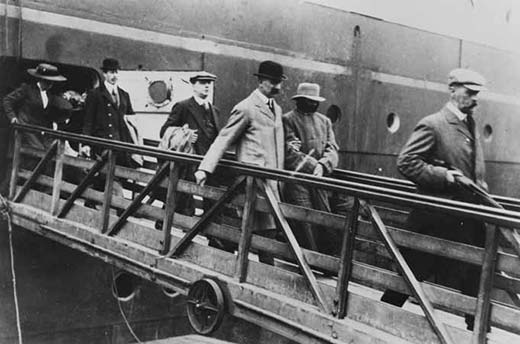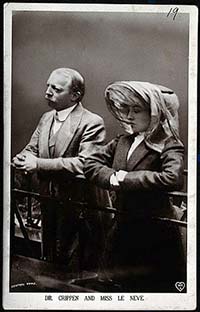Monday, 25 March 2024

Crippen - A case of Mistaken Identity?
Speaker: Dr Julian Somerville
The guest speaker at the u3a Todmorden Members Meeting on 21st March 2024 was Doctor Julian Somerville, with a talk entitled 'Crippen – A case of Mistaken Identity?'
Dr Hawley Harvey Crippen was born on the 11th September, 1862, in the United States. At the age of 21, he qualified as a doctor.
 While working at a New York hospital, Crippen stitched a wound sustained by Cora Turner, a 19 year old singer whose stage name was Belle Elmore. The wound left a scar.
While working at a New York hospital, Crippen stitched a wound sustained by Cora Turner, a 19 year old singer whose stage name was Belle Elmore. The wound left a scar.
A romance between them began, and Crippen and Cora married in 1893, although they were complete opposites - Crippen quiet and reserved, Cora full of life, vivacious and well liked by everyone who knew her. But Cora was by no means a good singer.
Crippen left America to work at the Drouet Institute in London, as a Homeopathic Specialist. There he met his secretary: Ethel Le Neve. Ethel was 21 years old, half Crippen's age. Crippen and Ethel started what was known then as a 'daytime' affair – which meant it was non sexual.
Cora knew nothing about this affair and, in 1905, she and Crippen moved into 39 Hilldrop Crescent, Holloway. Cora's singing career didn't pick up in England, and she became depressed and also started drinking. But in 1908 she became more positive, and got a job as Secretary for the Music Hall Ladies' Guild.
Meanwhile the 'daytime' affair between Crippen and Ethel had developed further – leading to Ethel miscarrying their child in 1909. Cora became aware of this, and threatened to leave, not for the first time.
Crippen and Cora had a joint bank account and, in December 1909, Cora went to the bank and asked to withdraw the whole amount. The request was declined, but Cora was able to obtain half of the money. Around the same time Crippen ordered a substance called Hyoscene, a poison, from his chemist – an amount sufficient to kill thirty people.
On the evening of 31 January 1910, Cora disappeared following a party at the Crippen residence.
A few days later, the Music Hall Ladies' Guild received two letters, supposedly signed by Cora. One was her formal resignation, and the other an informal letter – explaining that she had to return to America at short notice. But the recipients of the letters noticed that neither of them matched Cora's handwriting, which they knew.
Crippen and Ethel actually attended the ball held by the Music Hall Ladies on the 20th of February, where Crippen was very evasive when questioned about Cora. It was also noticed that Ethel was wearing a dress and jewellery that belonged to Cora. The following month, Crippen sent a telegram to the Guild which said that Cora had died in America.
It was another three months before the police became involved, and the officer in the case was Chief Inspector Walter Dew, of Scotland Yard. He spoke with Crippen, who admitted that he had sent the telegram saying Cora had died just to stop people asking questions about her. He went on to say that he thought she was alive, and living with another man.
After a search of Crippen's home address, Dew appeared to be satisfied with the account, and left to write up a report. The inspector went back to the address about two days later to check on some dates given by Crippen. But the house was empty, and Crippen and Ethel had both left their places of work. Dew became more than suspicious at this turn of events, and ordered searches of 39 Hilldrop Crescent, which eventually revealed human remains in the cellar. These included a piece of skin, which had a scar. Julian reminded us of the scar mentioned earlier in his talk. This, and other items, had been found in the fourth search of Crippen's address.
Crippen and Ethel had already left the country by this time, but Captain Henry Kendall, who commanded the SS Montrose heading for Canada, noticed a strange couple on board. They posed as a father and son, but their suspicious behaviour made Henry send a message to say that he thought the couple were the suspects. Inspector Dew immediately made his way to Liverpool and boarded a much faster ship, the SS Laurentic, which overtook the Montrose.

The photo above of the couple's arrest is very well known.
Subsequently, at the Old Bailey, Ethel was cleared of any charges but Crippen was sentenced to death, and was hung on 23rd November, 1910, at Pentonville Prison.
 Over four thousand people applied to witness the trial, but only eighty people were allowed to attend, such was the public interest in the case.
Over four thousand people applied to witness the trial, but only eighty people were allowed to attend, such was the public interest in the case.
The prosecution was led by Bernard Spilsbury. He presented evidence including the disappearance of Cora, the motive being the ability for Crippen to marry Ethel, a high percentage of the drug Hyoscine in the remains, and the dissection of the body. This, plus the scar on the piece of human skin, required a degree of surgical skill.
The skin had been wrapped in a pyjama jacket before being buried under stones. The defence counsel suggested that they had been placed there before Crippen moved into the house. But enquiries revealed that three sets of the pyjamas had been bought by, and delivered to, Crippen three years after he had moved in.
The jury were in no doubt over Crippen being guilty of the murder, taking only 27 minutes to reach their verdict. There was no appeal by the defence team.
But Julian said that it could be that this case may be, as the title of the presentation suggests, a case of mistaken identity – the identity being Cora's.
John Trestrail, an ex-FBI agent, took an interest in Crippen's case nearly a century afterwards. Mr Trestrail had an interest, and expertise, in investigating deaths by poisoning. He said that dismemberment of a body after the deceased had been poisoned was extremely rare at the time of Cora's death.
With colleagues, he was able to obtain a skin tissue sample, allegedly Cora's. Three of Cora's living relatives were found by a genealogist – which took seven years – and there was no match between the relatives and the supposed remains of Cora. The skin tissue sample held by the London Hospital since 1910 was that of a male person.
Julian pointed out other evidence never raised in court. There had been a witness who said that Cora had been seen supervising a man loading her trunk on to his cart, perhaps to take it to join a ship for her to return to the USA? Cora had a lot of money, and could have afforded to a make new life in America. Crippen was a Homeopathic doctor, not an experienced surgeon.
He also suggested that the murders carried out by Jack the Ripper in Whitechapel carried out in the late 1880's were all unsolved – did this cause a lack of faith and trust in the police, and influence proceedings?
Julian answered questions from the audience after his presentation and, perhaps, made some of the audience wonder whether it was a case of 'mistaken identity'. But we did know that this was an entertaining talk, which deserved our applause.
Not yet a member? We're always delighted to welcome new members. Contact details: website at www.u3atod.org.uk or email at info@u3atod.org.uk.
Many thanks to Colin Sanson for this report
Previous U3A reports on the HebWeb - click here

